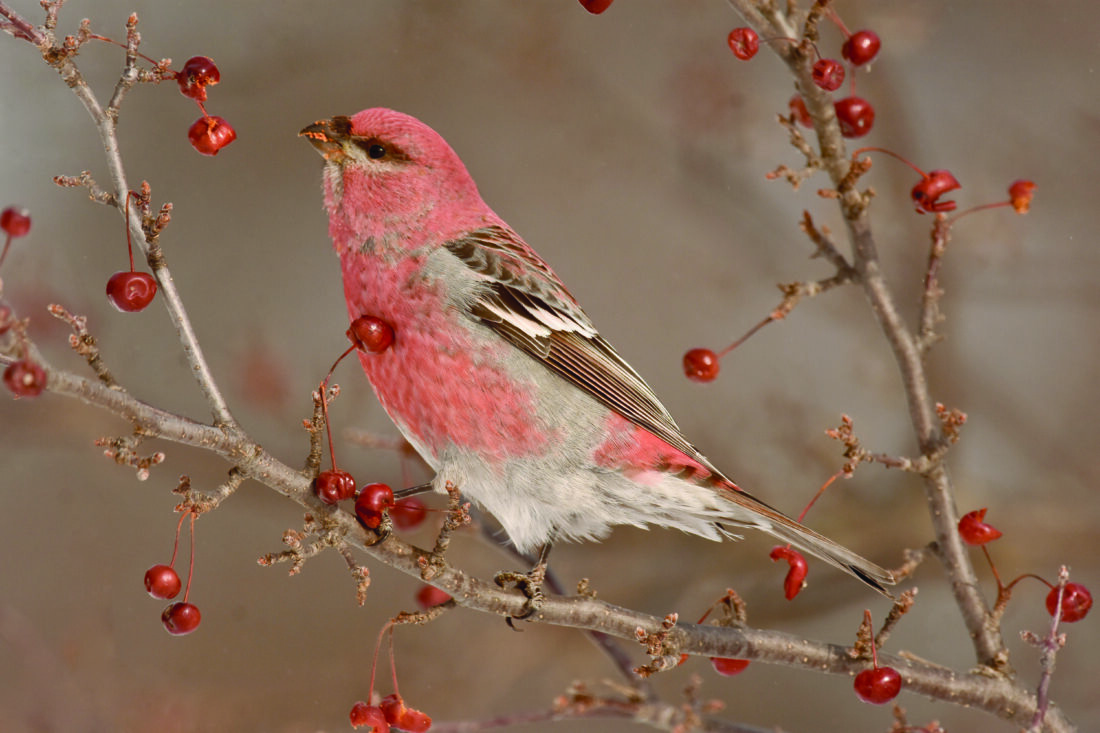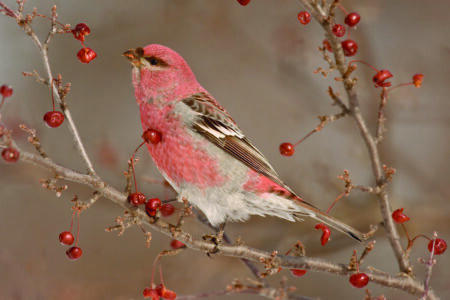What’s Flying: Surprises in the radiant light

A male pine grosbeak feeds. (Scot Stewart photo)
“The clear light that belongs to October was making the landscape radiant.” – Florence Bone
The recent sunshine brought a true radiance to the tree’s achieving their peak colors this past week. Nowhere was it more apparent than in the Park Cemetery in Marquette, where many of the brilliant colors were doubled in their pond reflections there. Rain this week, coming with some stronger winds, should bring down some of those radiant October leaves and any of that predicted snow will take down even more.
Along with the changes in weather have some changes in bird migration. Long-tailed ducks have been one of the species with big changes in the numbers passing through the Upper Peninsula this week. Nearly a thousand were counted daily on both Tuesday and Wednesday this past week.
American tree sparrows are also appearing in large numbers, especially in Alger County. On Monday 50 were seen near the Slapneck River east of Chatham. Later at the Chatham sewage lagoon 150 were seen. Both reports included a flock with around 20 dark-eye juncos.
Trumper swans are also beginning to move closer to winter habitats. On the south end of the Cleveland Basin east of Limestone in Alger County 74 swans were gathered Tuesday. In late autumn they begin to congregate there in preparation for winter. As other nearby waters freeze over dozens of trumpeters will head to nearby Trout Lake. Spring waters there keep the lake open all winter making it a favorable site. A flock of seven trumpeters, a pair of adults with five young, was recently seen in Negaunee Township too.

STEWART
New raptors are also showing up. This past Tuesday an Asio owl was seen at Whitefish Point. Too far away for a positive identification, it was either a long-eared or short-eared owl crossing Lake Superior into Michigan. One of the first rough-legged hawks of the fall was reported at the Point the following day.
Each autumn birders in the North Woods and Canada look forward to the release of the Winter Finch Forecast prepared by ornithologists in Ontario annually. The predictions are based on data collected across much of southern Canada examining mountain ash fruit crops, pine, fir, spruce, and tamarack cone crops, and the catkins of alder and birch trees. Data helps predict effects on the movements of Canadian songbirds during the winter months. Finches, including larger pine and evening grosbeaks, bohemian waxwings, blue jays, and red-breasted nuthatches, are covered in the predictions.
Mountain ash crops were poor this year north of Lake Superior so some southern movements of winter migrants into the Upper Peninsula are expected this winter. Some areas around the lower Great Lakes had extended dry periods this summer and will have poor crops too, but the area around Marquette does seem to have trees with a good crop of fruit. Pine grosbeaks are occasional winter guests in the U.P. and depend on mountain ash fruit. According to the forecast they should make it to the area.
Pine grosbeaks are a favorite winter bird in the U.P. for several reasons. Because most nest in boreal forests to the north many are unfamiliar with humans and appear quite tame. They have been known to fly into fruit trees while birders have stood nearby looking for them. Once in the trees feeding, they communicate with each other using soft, fluting calls that are quite beautiful. They also have an amazing ability to blend into the tree branches. Males have bright pink-red plumage with black and white trim. Females are more cryptic coloration with a blend of brown and olive with touches of yellow or orange
Because some spots like Marquette, Munising and Sault Ste. Marie also have good numbers of crab apple trees they will also keep any visiting pine grosbeaks here longer. Bohemian waxwings also feed on mountain ash and smaller crab apples too and may be expected to join the pine grosbeaks while the fruits hold out during winter and sometimes into early spring. In some years after snow melts in April fallen fruits are re-exposed for the birds still around, including returning robins.
Conifer cone productions were also poor across the forests of central Canada. The finch forecast noted with nearly no new cones and poor birch production across the area redpolls there would be a widespread split of many species heading either east to the Adirondacks and eastward to the Maritimes, or west to Manitoba and beyond. As a result, it is expected some white-winged crossbills may wander into the area along with some pine siskins and larger numbers of redpolls.
There was a massive eruption of red-breasted nuthatches earlier this fall into the U.P. and there should be a few more blue jays coming through too. There was a large spruce budworm hatch in Canada this summer resulting in a very productive nesting season for evening grosbeaks in Canada. With low cone crops to the north, there should be decent numbers of them in the U.P. this winter too. The past two years their numbers here have been very low so their larger return would be most welcome at area feeders. Because they are very social in winter, with flocks often quite chattery, they are difficult to miss when arriving. Some feeding stations in western Marquette County have seen as many as 300 evening grosbeaks visiting in past years during the winter months.
Lingering surprises include a continuing number of common grackles and red-wing blackbirds visiting feeders on the east side of Marquette this week. A few chipping sparrows are still around too. It’s a great time for
- A male pine grosbeak feeds. (Scot Stewart photo)
- STEWART



